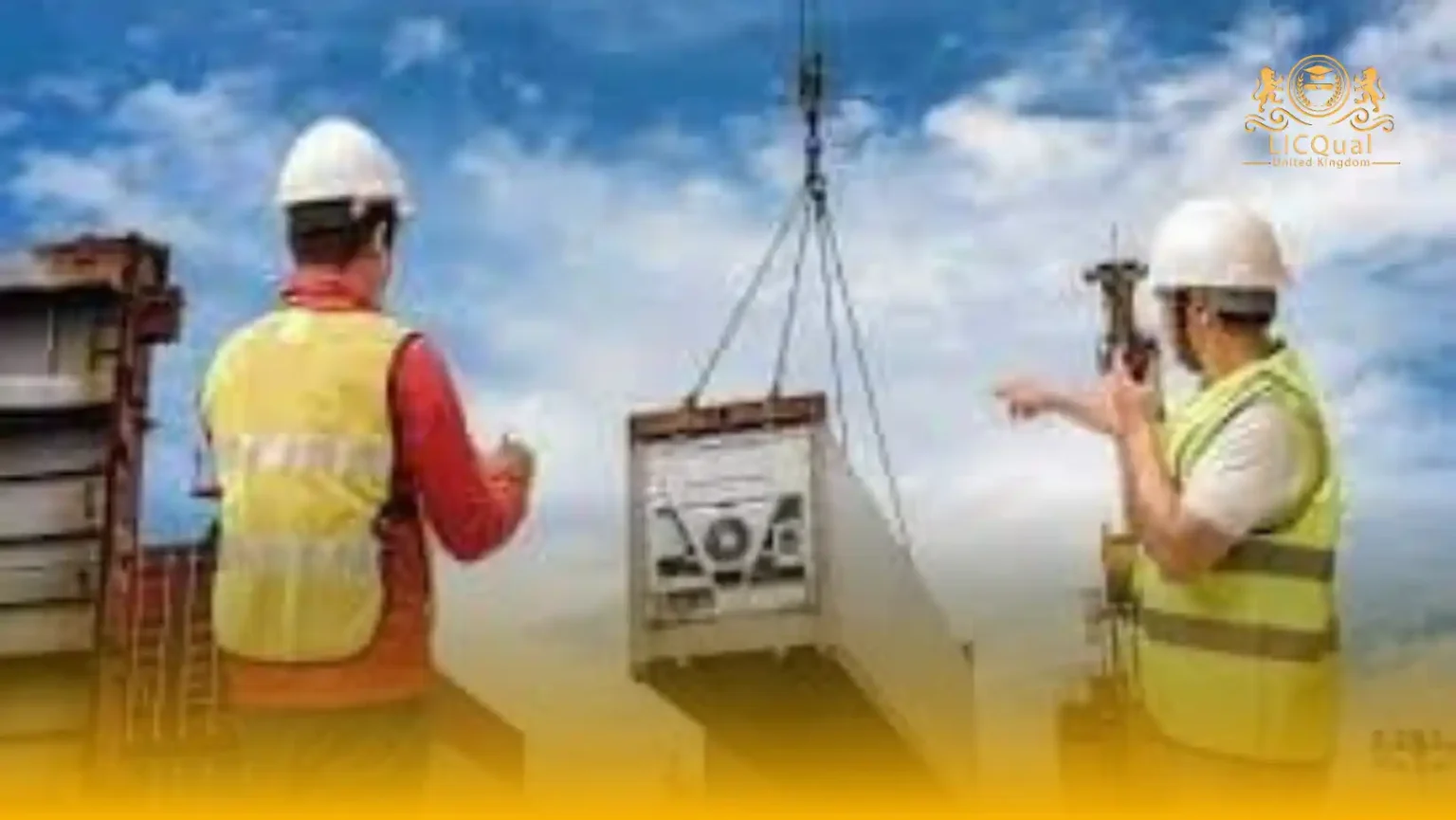The LICQual Level 2 Certificate in Slinger is an advanced qualification tailored for individuals who are looking to enhance their practical skills and knowledge in the slinging and lifting sector. This intermediate-level course is perfect for those who already possess some foundational knowledge of lifting operations and wish to build on their expertise in safe slinging and signaling techniques.
The course focuses on more complex lifting tasks, emphasizing precision, safety, and the correct selection of lifting equipment, making it a vital qualification for professionals in industries such as construction, logistics, oil & gas, and manufacturing.
The role of a Slinger is essential to the success of any lifting operation. As a key figure in directing crane movements and ensuring the load is correctly prepared, the slinger’s responsibilities include ensuring that lifting operations are safe, efficient, and compliant with regulatory standards.
The LICQual Level 2 Certificate in Slinger goes beyond basic training by offering in-depth knowledge on the proper use of lifting equipment, handling heavier and more complex loads, and understanding advanced techniques for load calculations, safety measures, and risk assessments.
A major focus of this qualification is on advanced load handling and slinging techniques. Participants will learn how to assess the weight and center of gravity of different loads, choose appropriate lifting methods, and correctly apply slinging techniques for different scenarios.
The course covers the proper inspection of lifting gear, ensuring all equipment meets safety standards, and highlights the importance of load stability. This in-depth understanding will equip learners with the skills to perform more complex tasks and contribute to safer, more efficient lifting operations.
Safety is a top priority throughout the LICQual Level 2 Certificate in Slinger. The course emphasizes risk management, hazard identification, and the use of personal protective equipment (PPE). Students will gain the knowledge required to ensure all lifting operations adhere to industry regulations, including the Lifting Operations and Lifting Equipment Regulations (LOLER). The qualification also provides learners with the tools to assess potential hazards in a work environment, implement safety measures, and communicate effectively with crane operators and other team members to ensure operations run smoothly.
In addition to safety and equipment handling, learners will develop advanced problem-solving and decision-making skills, enabling them to take on more responsibility within a lifting team. The LICQual Level 2 Certificate in Slinger also covers effective communication skills, ensuring that learners understand the importance of clear signaling and coordination with crane operators during lifting operations. These leadership skills are vital for ensuring that all team members are aligned, and any issues or risks are addressed proactively to maintain a safe working environment.
Upon successful completion of the LICQual Level 2 Certificate in Slinger, students will be awarded a nationally recognized qualification, enhancing their career prospects in the lifting and construction industries.
This certification not only boosts employability but also prepares learners for future progression into supervisory or more specialized roles, such as lifting supervisors or rigging professionals. Graduates will be equipped to handle more complex lifting operations and will be highly valued by employers seeking qualified, safety-conscious professionals.
Course Overview
Qualification Title
LICQual Level 2 Certificate in Slinger
Total Units
6
Total Credits
18
GLH
72
Qualification #
LICQ2200184
Qualification Specification
To enroll in the LICQual Level 2 Certificate in Slinger, applicants must meet the following criteria:
|
Qualification# |
Unit Title |
Credits |
GLH |
|---|---|---|---|
|
LICQ2200184-1 |
Advanced Slinging and Signalling Techniques |
3 |
12 |
|
LICQ2200184-2 |
Risk Assessment for Lifting Operations |
3 |
12 |
|
LICQ2200184-3 |
Equipment Selection and Handling |
3 |
12 |
|
LICQ2200184-4 |
Load Stability and Weight Calculation |
3 |
12 |
|
LICQ2200184-5 |
Communication and Coordination with Operators |
3 |
12 |
|
LICQ2200184-6 |
Legal and Regulatory Requirements |
3 |
12 |
By the end of this course, learners will be able to:
1. Advanced Slinging and Signalling Techniques
- Demonstrate the ability to apply advanced slinging and rigging techniques for complex and oversized loads.
- Understand and implement advanced signalling methods for clear communication with crane operators and the lifting team.
- Assess and adjust slinging techniques based on load types, weight, shape, and environmental conditions.
- Evaluate the safety of lifting operations through proper load distribution and rigging configuration.
- Apply advanced slinging techniques to handle irregular loads and ensure smooth and safe lifting operations.
2. Risk Assessment for Lifting Operations
- Conduct thorough risk assessments to identify potential hazards in lifting operations.
- Recognize risks associated with equipment failure, load instability, and environmental factors.
- Develop risk mitigation strategies to minimize or eliminate identified hazards before starting lifting tasks.
- Implement effective control measures to manage risks during lifting operations, ensuring compliance with safety standards.
- Understand how to adapt risk assessments based on the complexity of lifting operations and varying site conditions.
3. Equipment Selection and Handling
- Identify the key factors for selecting the appropriate lifting equipment based on load specifications, site conditions, and lifting requirements.
- Demonstrate the ability to inspect and evaluate lifting equipment for wear and damage before use.
- Understand the importance of selecting equipment that meets the safety requirements and limitations for specific lifting tasks.
- Safely handle and operate lifting equipment, ensuring it is properly maintained and stored.
- Recognize the impact of incorrect equipment selection on lifting operations and safety.
4. Load Stability and Weight Calculation
- Calculate the weight of loads accurately and apply this information to select the correct lifting equipment and slinging techniques.
- Understand the factors that influence load stability, including weight distribution, load shape, and lifting angles.
- Demonstrate the ability to ensure load stability throughout the lifting process.
- Assess and calculate the center of gravity of irregularly shaped loads to prevent instability during lifting.
- Apply knowledge of weight calculation and load stability to plan safe and efficient lifting operations.
5. Communication and Coordination with Operators
- Develop effective communication skills to relay clear instructions and signals to crane operators and the lifting team.
- Utilize appropriate hand signals and verbal communication methods to ensure clarity during lifting operations.
- Coordinate effectively with crane operators to ensure smooth execution of lifting tasks.
- Recognize the importance of maintaining continuous communication during operations to address any issues or changes in real time.
- Ensure that all team members understand their roles and responsibilities in the lifting operation through clear communication.
6. Legal and Regulatory Requirements
- Demonstrate a thorough understanding of the legal and regulatory framework governing lifting operations.
- Identify the relevant national and international safety standards and regulations that apply to slinging and lifting tasks.
- Understand the responsibilities of both employers and employees in ensuring compliance with safety regulations.
- Ensure that lifting operations are conducted in line with legal requirements to prevent accidents and avoid penalties.
- Apply industry-specific safety regulations in lifting operations to promote a safe and legally compliant working environment.
This diploma is ideal for:
Assessment and Verification
All units within this qualification are subject to internal assessment by the approved centre and external verification by LICQual. The qualification follows a criterion-referenced assessment approach, ensuring that learners meet all specified learning outcomes.
To achieve a ‘Pass’ in any unit, learners must provide valid, sufficient, and authentic evidence demonstrating their attainment of all learning outcomes and compliance with the prescribed assessment criteria. The Assessor is responsible for evaluating the evidence and determining whether the learner has successfully met the required standards.
Assessors must maintain a clear and comprehensive audit trail, documenting the basis for their assessment decisions to ensure transparency, consistency, and compliance with quality assurance requirements.







